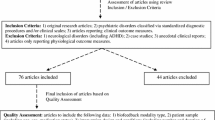Abstract
An essential function of both the Association for Applied Psychophysiology and Biofeedback (AAPB) and the Society for Neuronal Regulation (SNR) is the systematic evaluation of psychophysiological interventions that have been developed for the treatment of medical and psychiatric disorders. In order to address scientific concerns regarding the efficacy of specific clinical applications of biofeedback, these two societies formed and Efficacy Task Force. The process to be used in the assessment of treatment efficacy, specificity and clinical utility is presented in the form of a template that will serve as the foundation for a series of scientific reviews and practice guidlines to be published by both societies.
Similar content being viewed by others
Notes
This is similar to the “Dodo Bird Verdict” resulting from studies of the efficacy of different bona fide psychotherapies. It is suggested by some that available evidence supports the idea that all psychotherapies are nearly equal in terms of efficacy, see Wampold, D. E., Mondin, G.W., Moody, M., and Ahn, H. (1997). The flat earth as a metaphor for the evidence of uniform efficacy of bona fide psychotherapies: Reply to Crits-Christoph (1997) and Howard et al. (1997). Psychological Bulletin, 122 (3): 226–230.
While the use of randomized, controlled group designs enables a clinical researcher to control for certain sources of experimental “error,” it is erroneous to conclude that well-designed, case-controlled studies are of limited value. See Benson and Hartz (2000) for a comprehensive review of this topic.
REFERENCES
Benson, K., & Hartz, A. J. (2000). A comparison of observational studies and randomized, controlled trials. NewEngland Journal of Medicine, 342(25), 1878-1886.
Britton, A., McPherson, K., McKee, M., Sanderson, C., Black, N., & Bain, C. (1998). Choosing between randomized and non-randomized studies: A systematic review. Health Technology Assessment, 2(13), 1-124.
Concato, J., Shah, N., & Horwitz, R. I. (2000). Randomized, controlled trials, observational studies, and the hierarchy of research designs. New England Journal of Medicine, 342(25), 1887-1892.
Department of Health and Human Services. (1979). The Belmont Report. Retrived from http://ohrp.osophs.dhhs.gov/humansubjects/guidance/belmont.htm
World Medical Association. (2000). The Declaration of Helsinki. 52nd WMA General Assembly, Edinburgh, Scotland. Retrived from http://www.wma.net
Author information
Authors and Affiliations
Rights and permissions
About this article
Cite this article
La Vaque, T.J., Hammond, D.C., Trudeau, D. et al. Template for Developing Guidelines for the Evaluation of the Clinical Efficacy of Psychophysiological Interventions. Appl Psychophysiol Biofeedback 27, 273–281 (2002). https://doi.org/10.1023/A:1021061318355
Issue Date:
DOI: https://doi.org/10.1023/A:1021061318355




